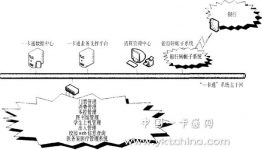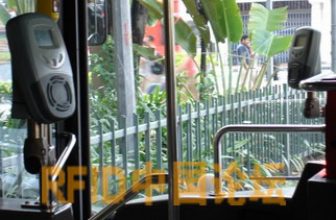
Case introduction of a large-scale campus all-in-one card system — A note on the all-in-one card system project of Ningbo Institute of Technology
[ad_1]
The traditional campus “all-in-one card” system generally only focuses on electronic consumption and applications. There is a lack of necessary design for the overall teaching management of the school. The “one-card” system has not been fully utilized in identification. Information transfer. Information storage. The advantages of information inquiry, etc., in the project of Ningbo Institute of Technology, the school proposes to carry out the planning and design of the all-in-one card system. It is necessary to play a full and active role in school education, teaching and management, and take the opportunity of establishing a campus card system. Establish various cardholders (faculty, staff, students) in schools. Basic various organizations. Unified information standards, strengthen centralized information management. Promote the construction of digital campus. include:
(1) Build a unified management all-in-one card business support platform in the campus network environment, system management of campus card applications, business charges, and bank transfers.
(2) On the basis of the basic data center of the campus all-in-one card system. Through the expansion connection 1:3 and intelligent control reserved by the system, it can realize the information exchange with the various MIS systems (such as management, scientific research, administration, logistics, etc.) and OA systems that the school is currently running, forming a school-wide digitalization Management space and shared environment. Dynamically and real-timely reflect the operation of functional departments and statistical analysis data, strengthen the basis of scientific decision-making by leaders, and improve the level of school management.
(3) Establish a connection between the campus all-in-one card system and the banking system, so that cardholders can automatically or self-service transfer bank card account funds to campus card e-wallets. Reduce cash flow and holdings, reduce financial management costs, and prevent the occurrence of financial cases.
(4) Use the electronic wallet in the campus card. It can be used universally for consumption activities at any consumer network on the campus. The “dedicated electronic wallet in the campus card can be set to be used only at specific dedicated consumer outlets according to needs, especially when water supply management is required for more than 2,000 student dormitories, and students need to pay for the use of the campus card according to the flow of water.
(5) Circulate cards using the all-in-one card system. As a realization that all the certificates in the school are replaced by campus cards. All card-using information management systems realize data sharing for identification, such as: computer room management, access control management, campus access management, campus Web query, etc.
It can be seen from the needs of the school that the all-in-one card of this project not only needs to realize various functions such as identity verification and billing management on the campus. It also needs to share information with other MIS systems and OA systems. In the later stage, it will also involve self-service transfer and settlement between campus cards and bank cards. The one-card pair from the construction of the overall structure to the realization of each specific subsystem. All put forward extremely high requirements. In the following pages, the author will mainly discuss the design of several key issues in the project, including: overall system structure design, real-time water control system design, and later bank transfer system planning.
In the following pages. The author will mainly discuss the design of several key issues in the project, including three aspects: overall system structure design, real-time water control system design, and later bank transfer system planning.
1 The overall structure design of the system

Figure 1 The overall topology of the campus all-in-one card system
The construction of the campus card system is a very complex system project (see Figure 1). According to the general requirements of the school campus card system, after conducting on-site inspections and investigations on the school’s education and teaching management and the school’s informatization construction, we follow The principle of unified planning and step-by-step implementation is to plan and design the all-in-one card information system from the height of the school’s digital campus. Ensure that the completed campus card information system can meet the needs of the school to build a digital campus in the future.
The one-card intranet is a dedicated communication environment between the one-card data center, the business support platform, and the bank-school communication gateway connected to the external system. Because of the complicated business processing between these devices, the communication security requirements are relatively high. Especially for bank network access, the security is very high. Therefore, a special all-in-one card intranet is set up to transfer the data exchange between all-in-one card service processing platform and data center. Transfer data exchange between the all-in-one card system and the banking system. The one-card private network adopts the TCP/IP network protocol, and the switches used in the entire one-card private network use port MAC address binding, so that each terminal can only set a unique IP address 1:3 to connect to a specific device. Thereby ensuring the security of the entire network.
One card is composed of multiple systems, including: one card data center, one card business support platform, management settlement center, bank transfer subsystem, business charging subsystem, access control management subsystem, attendance management subsystem, hospital charging subsystem, computer room management sub-system System, water control management subsystem, self-service query subsystem and third-party docking subsystem.
All in all, the campus all-in-one card system is based on the campus all-in-one card business support platform and the campus network as the carrier. It adopts a centralized management mode for data management, but the functional modules are independent (that is, using 1+X modularity). Construct. Based on the campus network and all-in-one card business support platform, in accordance with the school campus all-in-one card system and the overall requirements for building a digital campus all-in-one card, build subsystems such as business charges, bank transfers, access control, attendance management, computer room management, school property management, and independent query And use the third-party interface of the all-in-one card system to realize the docking with the existing information management system of the college.
2 Design of water control management subsystem
Water control management is the transformation of the original water pipes and the lc card technology is embedded in it, so that students need to swipe their cards to charge according to the flow of water in the dormitory. This on the one hand improves the students’ awareness of water conservation and saves valuable water resources; on the other hand, it also eliminates the unfair charges caused by the “flat-sharing” of water use in the dormitory. Compared with subsystems such as access control management and canteen consumption management in this project, water control management is a more difficult link to deal with. This is because firstly the number of water control points is very large. The school will install a water-saving control system in every student dormitory, totaling more than 2,000 water control points, and the amount of water control system involved requires extremely high levels of management. Stable operation ability and data accounting ability. In this project, in order to meet the simultaneous use of such a huge water control node, we designed the Mifare IS50 non-contact lC card to write the e-wallet amount in a certain sector of the card and obtain the actual water flow from the water-saving controller electronic water meter. Real-time management is achieved by deducting the amount in the card in real time. In the system structure, the network topology is shown in Figure 2 with the combination of TCP/IP area controller + RS485 local water controller.

Figure 2 Topological structure diagram of water control system
A regional controller is installed in the weak current room of each floor. The regional controller of each building is connected to the school’s “one-card” backbone network through a switch to exchange data with the upper-level clearing system. Each area controller can be connected to 3 RS485 buses, but for the convenience of construction, only two are needed in this project. Each RS485 line on the left and right must be connected to 20 intelligent water-saving controls “hand in hand”. Device. Each water-saving controller is connected to an external water meter, solenoid valve and other equipment to complete the control of the water in the bedroom. The installation diagram is shown in Figure 3.

Figure 3 Schematic diagram of water-saving controller installation
The system adopts the mode of charging according to the flow rate. Each water-saving controller can be connected with 2 water meters, 2 solenoid valves, and set 2 different rates, so as to deduct the cold water and hot water at the same time. In this project, fc card water control management is only adopted for the hot water supply of the dormitory according to actual needs. The system adopts a prepaid method for management, and the normal use process is as follows:
Put the card-press the start button-water out-press the stop button-take out the card
In this way, the water-saving controller is responsible for the specific operations of each swiping card, while the regional controller is responsible for real-time data collection of the lower-level intelligent water-saving controller and upload it to the clearing center. Using this mixed communication method of TCP/IP and RS485, the processing speed of the system can be greatly shared while expanding the huge nodes: more than 2000 huge water control points, the upper management software only needs to be responsible for the TCP/ of more than 50 regional controllers. IP communication is sufficient, and the load is extremely low. Significantly reduces the large number of round-robin and processing tasks that need to be spent when using the traditional RS485 communication method. So that the system can achieve very large processing capacity and very fast processing speed. At the same time, each regional controller stores 30,000 data, so that the data capacity of each water-saving controller in the lower layer is buffered, thereby greatly improving the stability of the system.
3 Bank transfer system
The system is an extended function system in the later stage of the project, which can change the manual cash deposit mode of the bank card account to the deposit mode of automatic transfer or self-service transfer through the cardholder’s bank account, so as to bring greater convenience to teachers and students in using the all-in-one card system. This system requires the bank to establish the corresponding transfer business according to the data interface and communication protocol of the transfer system. The two major systems initiate a transfer request to the school gateway front-end computer through the bank gateway front-end processor, and realize the account fund transfer between the systems through the DDN dedicated line. Accounting settlement. See Figure 4.

Figure 4 Network structure topology diagram of bank transfer system
The system description is as follows:
(1) Campus network
Including the original campus card system, campus gateway front-end machine and “Bank-School Link” self-service transfer equipment, etc. Campus gateway front-end processor: It is the data transfer interface between the campus Mls system and the banking system. Loading the campus gateway software can simultaneously communicate with the bank host and various self-service transfer terminals, and also supports wireless communication (SMS or GPRS) from remote self-service transfer terminals. Using DDN to connect with the bank front-end computer is responsible for account processing and day-end billing with the bank host and campus MIS host respectively, and is responsible for printing standard communication data packets to record the transaction flow, printing the day-end report, and so on.
(2) Bank-side network
Including bank account host, bank gateway front-end machine, etc. Bank gateway front-end processor: connect to campus gateway machine through DDN, and process the accounting information from campus gateway machine. Including packet encryption and decryption, packaging and unpacking, transaction concurrency control and transaction legality verification, etc., it will be sent to the bank account host.
(3) Self-service transfer terminal
The system uses transfer terminals to realize the transfer of funds between bank cards and campus cards. The student (or parent) deposits the money in the bank account of the campus card, and when it needs to transfer, the student transfers the money from the bank account to the school account through the transfer terminal, and the student can use the card to consume on campus. At this time, the corresponding functions and management are implemented by the school, and the bank and the school only need to ensure that the transferred records and amounts are consistent. The specific transfer process is shown in Figure 5.

Figure 5 Flow chart of self-service transfer
In addition to the three key aspects discussed above, the all-in-one card subsystems actually used in the project also include: administrative building, access control management of important rooms in the teaching building, on-campus canteen, small shopping department and other consumer systems, and on-campus computer room Computer management system, library interface management system, Web information query (all-in-one card information), school medical office medical management system, etc. At the same time, the cardholder’s personal information is printed on the surface of the card, which is used as the cardholder’s ID card on campus. The all-in-one card completely replaces the traditional post card, student school card, etc., which saves school resources and avoids duplication of construction. On campus, students have fully realized the operation of various identity authentication and fund settlement with one card, and reached the design goal of “one card in hand, travel all over the campus”.
It can be seen from this project that the campus “all-in-one card” system is not only conducive to improving the school’s modern teaching management level, but also bringing great convenience to the campus life of teachers and students. The construction of the “One Card” system has good practical application value for accelerating the pace of intelligent construction of schools. The author believes that with the continuous popularization of the campus “One Card” system, it will definitely have a positive and far-reaching effect on my country’s education informatization. Influence.
[ad_2]






